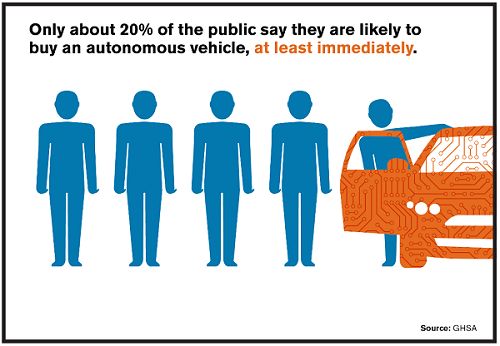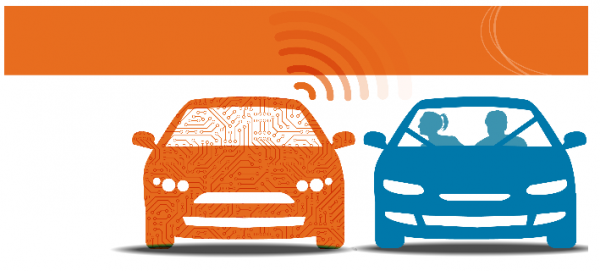
As autonomous vehicles (AVs) merge into our nation’s traffic, the most pressing safety challenge for states will be preparing human drivers, and Vermont is no exception.
The Governor’s Highway Safety Association prepared a report that examines the implications of new vehicle technologies for highway safety agencies and advocates. You can read it here: Autonomous Vehicles Meet Human Drivers: Traffic Safety Issues for States.
The infographics below highlight some of the information shared in the report.
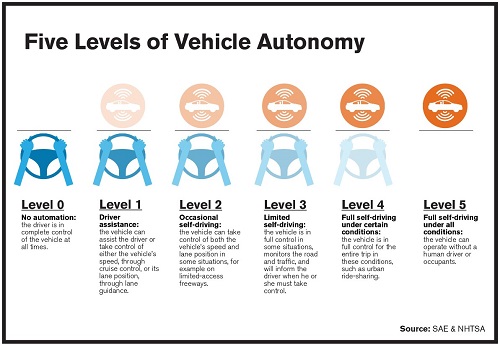
Potential Benefits & Consequences of Driverless Cars
- Crash reduction
- 94% of crashes tied to human choice or error
- Benefits depend on level of automation
- One third reduction in crashes with level 0 and 1 automation (forward collision & lane departure warning, blind spot assist, adaptive headlights)
- Transition to Level 4 or 5 automation (driver attention not required) could help reduce the number of impaired driver related crashes (cause for 39% of fatalities)
- Benefits drivers/passengers of AVs and other highway system users
- Personal mobility improvements for persons with disabilities, older people, younger people
- Potential reduction in driver costs
- Opportunity to reduce parking in downtowns and other built‐up areas, reduced development costs
- May continue to support dispersed land use pattern
- Could be a competitor for transit, or may be integrated and support transit
- Effect on vehicle miles travelled uncertain
- More efficient use of existing highway capacity, reduce need for new capacity in some cases
- May facilitate conversion to electric vehicles, emission reduction & transportation fund impacts
Division of State and Federal Responsibilities
- Federal Government (NHTSA) is responsible for regulating motor vehicles and motor vehicle equipment ‐> targeted at manufacturers
- State government (and local governments) is responsible for regulating drivers which involves licensing “human” drivers, vehicle registrations, establishing and enforcing traffic laws, regulating motor vehicle insurance and liability
- States may also choose to require safety inspections
- Expect that Federal/State responsibilities will stay the same
State Policy Purpose
- Avoid patchwork of non‐consistent regulations,
- Ensure safe deployment of new technology
- Avoid delaying deployment of lifesaving technology
- Make sure Vermont is positioned to take advantage of new technologies – let’s not fall behind
Topics for Vermont’s Automated Vehicle Future
- Determine statutory requirements to implement a framework and regulations around:
- Licensing/registration
- Driver education and training
- Insurance and liability
- Enforcement of traffic laws/regulations
- Administration of motor vehicle inspections
- Establish process for manufacturers or other entities to apply for and test AVs on Public Roadways
- Establish process for deployment of AVs by the public
- Law Enforcement Considerations
- How to limit driver distractions for semi‐automated vehicles
- Emergency response protocols
- Liability and Insurance
- Who should carry motor vehicle insurance (owner, operator, passenger, manufacturer, etc.)
- Transportation infrastructure requirements
- Explore broader policy issues
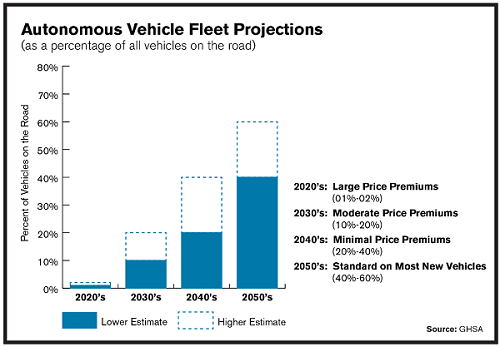
Common Issues Addressed by Other States in Executive Orders and Legislation
- Should an operator be physically present (and in driver’s seat) and ready to take over during testing?
- Should special rules be developed to ensure safe testing and operation?
- Should there be special training and certifications required for operators of AVs?
- How to regulate conversion of conventional vehicles into autonomous vehicles. Limit to recent models? How to address the liability of the original manufacturer of a converted vehicle.
- Should hand‐held devices be allowed for use in a legally operating autonomous vehicle?
- Should local governments be able to ban AVs on local roads?
- Should VT identify Autonomous Vehicle Corridors?
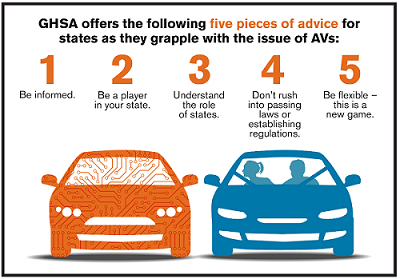
For more information on autonomous vehicles here in Vermont, you can email Joe Segale at Joe.Segale@vermont.gov or call him at the Vermont Agency of Transportation (802) 828 3968.
Additional web based information can be found at ...
- NHTSA - Automated Vehicles
- GHSA - Autonomous Vehicles
- NHTSA - Vehicle to Vehicle Communications
- NHTSA - Vehicle Cybersecurity
- AAMVA - Autonomous Vehicle Information Library
- Where to? A History of Autonomous Vehicles

